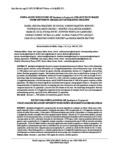Use este identificador para citar ou linkar para este item:
http://www.alice.cnptia.embrapa.br/alice/handle/doc/1049220| Título: | Population structure of Spodoptera frugiperda collected in maize from different Brazilian geographic regions. |
| Autoria: | SOUZA, I. R. P. de  MENDES, S. M.   RAFAEL, H. A.   BARROS, B. de A.   PINTO, M. de O.   CARNEIRO, N. P.   LANA, U. G. de P.   LANDAU, E. C.   RIBEIRO, C. A. G.   PASTINA, M. M.   |
| Afiliação: | ISABEL REGINA PRAZERES DE SOUZA, CNPMS; SIMONE MARTINS MENDES, CNPMS; HENRIQUE ALBANO RAFAEL, UNIFEMM; BEATRIZ DE ALMEIDA BARROS, CNPMS; MARCOS DE OLIVEIRA PINTO, CNPMS; NEWTON PORTILHO CARNEIRO, CNPMS; UBIRACI GOMES DE PAULA LANA, CNPMS; ELENA CHARLOTTE LANDAU, CNPMS; CARLOS ALEXANDRE GOMES RIBEIRO, UFV; MARIA MARTA PASTINA, CNPMS. |
| Ano de publicação: | 2015 |
| Referência: | Revista Brasileira de Milho e Sorgo, Sete Lagoas, v. 14, n. 3, p. 300-315, 2015. |
| Conteúdo: | ABSTRACT: Spodoptera frugiperda is the most economically important maize pest in Brazil. There is little information about the genetic structure, using SSR markers, of S. frugiperda populations collected from maize crops. In this study, 21 SSR markers were used to evaluate the genetic diversity and population structure of S. frugiperda collected from distinct Brazilian geographical regions. Two hundred and twenty-seven alleles were recorded with an average of 10.76 per marker, and Polymorphic Information Content (PIC) values ranging from 0.242 to 0.933, with an average of 0.621, indicating a high discriminating power. The overall FST, 0.061, indicated a moderate genetic differentiation among the S. frugiperda populations collected from maize, and the AMOVA showed that 87.36% of the genetic variation is within populations. The Mantel test showed significant correlation between genetic and geographic distances. The genetic data demonstrated that all individuals from the six sampling sites were structured as two sub-populations, being one of them composed only by the CL population, collected in the Rio Grande do Sul state. The knowledge about genetic diversity and population structure of S. frugiperda is important for the development of strategies for the insect pest management and monitoring systems, especially for the differentiated CL population. RESUMO: Spodoptera frugiperda é a praga do milho de maior importância econômica no Brasil. Existe pouca informação disponível sobre a estrutura genética, utilizando marcadores SSR, de populações de S. Frugiperda coletadas em cultivos de milho.Neste estudo, 21 marcadores SSR foram utilizados para avaliar a diversidade e a estrutura genética de S. frugiperda coletadas em regiões brasileiras geograficamente distintas. Um total de 227 alelos foram obtidos, com uma média de 10,76 alelos por marcador, e os valores do Conteúdo de Informação Polimórfica (PIC) variaram de 0,242 a 0,933, com uma média de 0,621, indicando alto poder de discriminação. O FST geral, 0,061, indicou moderada diferenciação genética entre as populações de S. frugiperda coletadas em milho e a Amova mostrou que 87,36% da variação está dentro de populações. O teste de Mantel mostrou correlação significativa entre distâncias genéticas e distâncias geográficas. Os dados genéticos demonstraram que todos os indivíduos dos seis locais de amostragem foram estruturados em duas sub-populações, sendo uma delas composta apenas pela população CL, coletada no estado do Rio Grande do Sul. O conhecimento sobre a diversidade genética e a estrutura populacional de S. frugiperda é importante para o desenvolvimento de estratégias para os sistemas de manejo e monitoramento de insetos-praga, especialmente para a diferenciada população CL. |
| Thesagro: | Zea mays Lagarta |
| Palavras-chave: | Estrutura genética |
| Digital Object Identifier: | 10.18512/1980-6477/rbms.v14n3p300-315 |
| Tipo do material: | Artigo de periódico |
| Acesso: | openAccess |
| Aparece nas coleções: | Artigo em periódico indexado (CNPMS)  |
Arquivos associados a este item:
| Arquivo | Descrição | Tamanho | Formato | |
|---|---|---|---|---|
| Populationstructure.pdf | 1,12 MB | Adobe PDF |  Visualizar/Abrir |









